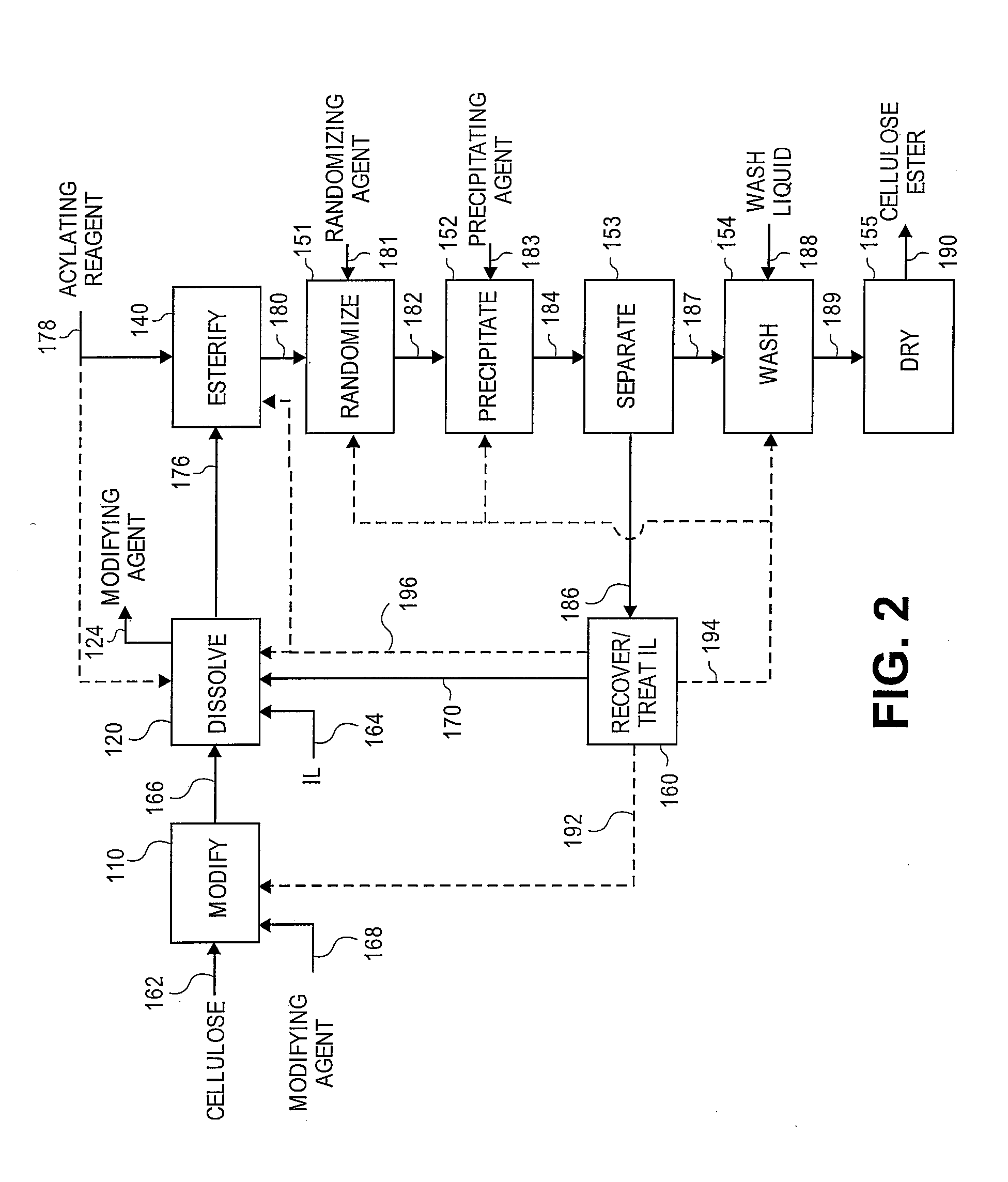Treatment of cellulose esters
a technology of cellulose esters and ionic liquids, which is applied in the field of cellulose esters and/or ionic liquids, can solve the problems of insufficient methods and apparatuses for reforming and/or recycling ionic liquids, the inability to use ionic liquids as solvents in many processes, and the cost of ionic liquids
- Summary
- Abstract
- Description
- Claims
- Application Information
AI Technical Summary
Benefits of technology
Problems solved by technology
Method used
Image
Examples
example 1
Preparation of Cellulose Ester (Comparative)
[0170]A 3-neck 100 mL round bottom flask, fitted with two double neck adapters for a total of five ports, was equipped for mechanical stirring, and further included an iC10 diamond tipped IR probe (Mettler-Toledo AutoChem, Inc., Columbia, Md., USA) and an N2 / vacuum inlet. To the flask was added 61 g of 1-butyl-3-methylimidazolium chloride (“[BMlm]Cl”), which, prior to addition, had been melted at 90° C. and then stored in a desiccator where the [BMlm]Cl remained a liquid. While stirring rapidly, 3.21 g of previously dried microcrystalline cellulose, having a DP of about 335, was added in small portions over a period of 3 minutes. The slurry was stirred for 5 minutes and then placed under vacuum. After approximately 3 hours and 25 minutes, most of the cellulose had dissolved except for a few small pieces and 1 large piece attached to the probe. After 5.5 hours, the oil bath temperature was increased to 105° C. to speed up dissolution of the...
example 2
Modification of Cellulose with Water
[0174]A 3-neck 100 mL round bottom flask, fitted with two double neck adapters for a total of five ports, was equipped for mechanical stirring, and further included an iC10 diamond tipped IR probe (Mettler-Toledo AutoChem, Inc., Columbia, Md., USA) and an N2 / vacuum inlet. To the flask was added 64.3 g of [BMlm]Cl, which, prior to addition, had been melted at 90° C. and then stored in a desiccator where the [BMlm]Cl remained a liquid. While stirring rapidly, 3.4 g (5 weight percent) of microcrystalline cellulose, having a DP of about 335, was added at ambient temperature. Approximately 12 minutes after adding the cellulose, the flask was placed in a preheated 80° C. oil bath. After about 17 minutes in the 80° C. oil bath, upon visual inspection all of the cellulose appeared to be dissolved. A vacuum was applied after approximately 22 minutes in the 80° C. oil bath. To insure complete removal of water, 50 minutes after applying vacuum, the oil bath ...
example 3
MSA Secondary Component, No Modification with Water
[0179]3.58 g of cellulose (5 weight percent) was dissolved in 68 g of [BMlm]Cl in a manner similar to Example 2. At a temperature of 80° C., a mixture of 433 mg (0.2 eq.) of methane sulfonic acid (“MSA”) and 6.76 g of Ac2O (3 eq.) was added to the cellulose solution dropwise over a period of 8 minutes. The reaction was sampled throughout the reaction period by removing 6 to 10 g aliquots of the reaction mixture and precipitating in 100 mL of MeOH. The solid from each aliquot was washed twice with 100 mL portions of MeOH then dried at 60° C. at a pressure of 5 mm Hg. The solid samples were snow white. After approximately 2 hours, all of the Ac2O appeared to be consumed, according to the IR spectrum. The experiment was aborted and the remaining sample was processed as above.
[0180]The precipitation and the wash liquids from each aliquot were combined and concentrated in vacuo at 68° C. until the vacuum dropped to 24 mm Hg, which provid...
PUM
| Property | Measurement | Unit |
|---|---|---|
| polydispersity | aaaaa | aaaaa |
| weight percent | aaaaa | aaaaa |
| weight percent | aaaaa | aaaaa |
Abstract
Description
Claims
Application Information
 Login to View More
Login to View More - R&D
- Intellectual Property
- Life Sciences
- Materials
- Tech Scout
- Unparalleled Data Quality
- Higher Quality Content
- 60% Fewer Hallucinations
Browse by: Latest US Patents, China's latest patents, Technical Efficacy Thesaurus, Application Domain, Technology Topic, Popular Technical Reports.
© 2025 PatSnap. All rights reserved.Legal|Privacy policy|Modern Slavery Act Transparency Statement|Sitemap|About US| Contact US: help@patsnap.com



